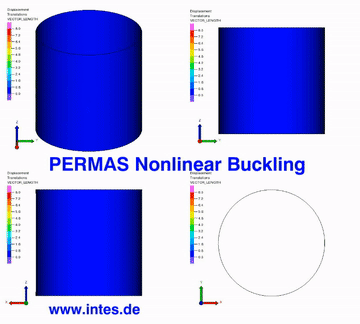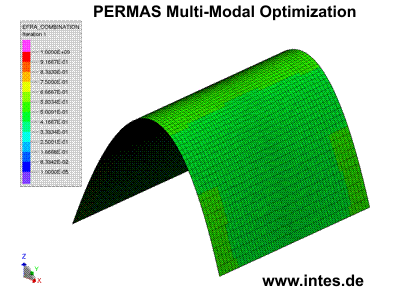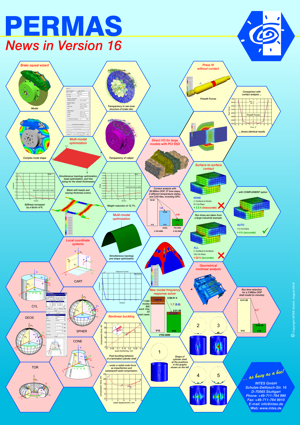New Features in PERMAS Version 16
The new Version 16 of PERMAS is the result of about 24 months of development work.
For a complete and detailed overview on changes, a Software Release Note
is shipped with Version 16.
Great effort has been spent in the past years to provide with
VisPER (i.e. Visual PERMAS) a dedicated tool to improve pre- and
post-processing for special PERMAS functions. The fourth regular
VisPER Version 5 is released at the same time as PERMAS
Version 16.
- PERMAS V16 offers again improved computing performance:
-
- PERMAS can be invoked using a new option for using direct I/O. If PERMAS DMS-Files are put on SSD systems, the I/O is performed directly using the PCI bus to these systems, which can reduce run time for I/O bound jobs significantly.
- Again improved algorithm for direct FS coupled frequency response analysis.
- A new very fast modal frequency response solver (SMW-solver) has been developed.
- Geometrically nonlinear analysis has been essentially accelerated.
- New Module
-
- The new module ADS provides an interface between the casting simulation software ADSTEFAN (owned by Hitachi Industry & Control Solutions, Ltd., see http://www.adstefan.com) and PERMAS. The interface supports the import of the temperature distribution of the casting simulation, provided as voxel data in a csv format.
- Major extensions
-
- Extensions to Basic Module (Module MQA):
- The concept of local coordinate systems has been extended to support a larger variety of coordinate system types.
- For surfaces with quadratic elements, a linearization is available, which makes the midside nodes linearly dependent on the corner nodes. If these surfaces are used in contact definitions, then the surfaces will also provide contact pressure results. A special export item allows to visualize the surface definitions. Definition and visualization of surfaces are fully supported by VisPER.
- Multilinear kinematic constraints for surfaces (by MPC conditions) provide a new projection feature, where the dependent node coordinates can be modified to place them on the surface. Alternatively, a rigid lever arm will be used between the dependent nodes and the surface.
- For the PERMAS results export, a binary format has been introduced based on the widely used HDF5 library (see https://www.hdfgroup.org/HDF5/). The main effect of this binary format is the reduction of time needed to export the results. In addition, a slight reduction of file size is achieved compared to the gzipped ASCII export file format used so far.
- In previous PERMAS version, sampling has been introduced as a method to repeat an analysis many times with modified discrete values. In order to reduce the number of samples without losing information about parameter influence a new sampling method (i.e. LHC Latin Hypercube Sampling) has been developed.
- In previous versions of PERMAS, press fit connections have been modeled and analyzed by contact using a negative gap width indicating the interference of the unconnected parts. In case, an opening of the gap in a press fit connection during operational loading is not of interest to the analyst, then there is a new modeling feature for press fit connections available. This feature uses MPC coupling instead of contact conditions. Examples show exactly the same results as for contact analysis. This new method is a linear method and works for static and dynamic analysis and other analysis types. Even substructuring with the press fit connection in a substructure is possible with this method. Specific results are available to verify, check, and evaluate press fit connections.
- Extensions to Contact Analysis (Modules CA/CAX/CAU):
- In surface-to-surface contacts, more contacts are taken into account than in surface-to-node contacts. More contacts typically give more accurate results but also longer computation times. Less contacts does not mean that the results become inaccurate, but it is possible e.g. for coarse meshes of contact surfaces. In order to get the best out of a contact analysis by spending only moderately more computation time, an optional automatism has been developed (option COMPLEMENT), which reduces the number of contacts in surface-to-surface contact areas in a way that the accuracy is preserved.
- For each contact definition with a non-zero sum of contact forces, there exists a line of action with a minimal resultant torque due to the corresponding normal and frictional contact forces. The point on that line of action, which lies closest to a given centroid (e.g. the center of contact node coordinates) is defined as the contact's center of pressure (COP). The coordinates of the COP and the sum of forces and moments is written to the result file by request. This result is available for all load steps performed in a linear or nonlinear contact analysis.
- A new gap function has been introduced, where a given gap may be scaled by a user-defined function, which may depend on the position in space and topological information.
- Extensions to Nonlinear Static Analysis (Module NLS):
- The existing post-buckling feature has been improved by enhancements of the solid shell elements and a newly implemented arc length method. In addition, a linear buckling analysis can be performed after each converged nonlinear load step.
- It is now possible to switch automatically from linear shell elements to nonlinear solid shell elements dependent on the analysis type used.
- The performance of geometrically nonlinear analysis has been improved by reducing the number of automatic load steps and iterations.
- Extensions to Extended Dynamic Eigenvalue Analysis (Module DEVX):
- A new parallelized complex eigenvalue solver has been developed.
- Extensions to Dynamic Eigenvalue Analysis with MLDR (Module MLDR):
- Faster Craig-Bampton mass and damping reduction.
- Temperature-dependent stiffness is taken into account.
- In order to support a subsequent response analysis, assembled situations and static mode shapes are considered. Also static modes due to inertia loads from inertia relief analysis can be used.
- Extensions to Dynamic Response Analysis (Module DRA):
- For models with many eigenvalues, many excitation frequencies, and only some dampers the computation of the frequency response is expensive. As long as the damping is not frequency dependent (only a few discrete dampers), a diagonalisation of the system is possible via a singular value decomposition (complex eigenvalues). An explicit inversion of the resulting system matrix may be performed, applying the Shermann-Morisson-Woodbury (SMW) formulation. The subsequent computation of each frequency point is cheap. This new SMW solver is much faster than the general solver for modal frequency response analysis.
- Extensions to Extended Dynamics (Module DRX):
- Modal random response analysis has now better numerical stability and the generation of cross spectral densities was improved.
- Extensions to Fluid-Structure Acoustics (Module FS):
- The direct time integration for the response in time domain for fluids only is now available.
- Extensions to Parametric Design Optimization (Module OPT):
- Due to a harmonization of the optimizers now any combination of topology, sizing, and shape optimization can be used simultaneously in one single multi-modal optimization (MMO). To get to this point, the mentioned optimization types are using the same solver. This opens the door to new and not yet feasible optimization tasks.
- A new additional solver Adapted Convex Programming (ACP) solver has been added to the list of optimization solvers. This out-of-core and parallelized solver is recommended for large optimization tasks, nonlinear behavior, and complex manufacturing conditions.
- Optimization has been equipped with a general break/restart facility. To this end, a running optimization can be stopped and restart files are prepared. So, the restart can be made at any already performed optimization loop. Before restart, optimization parameters can be modified to influence the convergence behavior of the optimization. The restart uses the restart file to continue the optimization from the already reached status.
- The use of external tools in optimization loops is now possible. First examples are used to calculate safety factors, which are used as objective or constraint in a free-form optimization. To achieve that a script has to be written, which invokes the external tool and provides nodal results in a specific PERMAS compliant format.
- Before Version 16, one design constraint has to be selcted as design objective. Now with Version 16, an arbitrary number of design coinstraints may be declared as design objective. The maximum value will be minimized, whereas all others become constraints.
- For multi-objective design optimization a Pareto optimization may be performed using a suitable sampling capability.
- Extensions to Non-parametric Design Optimization (Module OPT):
- A new solver for the optimality criteria method with additional constraints has been developed.
- Possible objectives or constraints are weight, stress (von Mises stress, principal stress), effective plastic strain, and nodal values generated by external tools (see above), if a local change of the part thickness influences the local value of the objective (e.g. safety factors).
- Additional constraints could be stresses outside the design area, displacements or compliance as stiffness constraints or any other constraint as long as (semi-)analytic sensitivities are available.
- Of particular importance is the element test as additional constraint, which is used to avoid a stop of the optimization process due to failing elements.
- The relaxation of nodes in the design area due to the thickness change is fully redesigned.
- Release directions are available for free-form optimization as manufacturing constraint.
- Extensions to Topology Optimization (Module TOPO):
- Topology optimization can now be made with multiple materials in design area.
- Topology optimization can be used for free sizing of geometrical properties (e.g. sheet thicknesses).
- Special improvements for frequency response optimization made this optimization task much faster.
- Extensions to Advanced Optimization Solvers (Module AOS):
- A new Global Design Centering (GDC) option for optimization has been implemented. This option has been developed to search for a domain with maximum stability. A typical example application is brake squeal analysis with stochastic parameters for brake pad material.
 Nonlinear buckling of a composite cylinder shell
Nonlinear buckling of a composite cylinder shell
under axial loading and radial force as imperfection. Multi-Modal Optimization of a cylindrical shell.
Multi-Modal Optimization of a cylindrical shell. - Extensions to Basic Module (Module MQA):
- New Elements
-
- A new gasket element formulation has been introduced. Now, at common nodes gasket elements with different materials can be inserted and a split of the gasket areas with different material properties is not necessary any more. Therefore, the pressure-closure curve of the gasket elements can have an initial zero slope to represent different heights of the various gasket areas while using a unified height of all elements in a gasket.
- Other extensions
- Many smaller extensions of almost all functional modules had been performed in addition. Moreover, all interfaces were updated and
adapted to the new functionalities. Most important interface enhancements are:
- Medina
- Support of MEDINA 9.0,
- Export of new PERMAS Version 16 results.
- Abaqus
- Translation adapted to new PERMAS features like for contact and gasket modeling,
- Support of connector actuation definitions,
- Extended user controls for model translations,
- Interaction with messages and overview tables in VisPER.
- Nastran
- Extended support of OUTPUT2 and OUTPUT4 format.
- Excite
- Support of EXCITE Version 2013.2,
- A special command has been provided, which after a vibration analysis of a reduced flexible part may be used to modify mass and stiffness matrices to shift eigenfrequencies according to user specification. The modified data objects are intended to be exported to EXCITE. By this feature, what-if studies are supported to find the optimal properties of the reduced flexible part without modifying the model beforehand.
- Medina
For all system platforms an update to the current release of the operating system had been performed.
